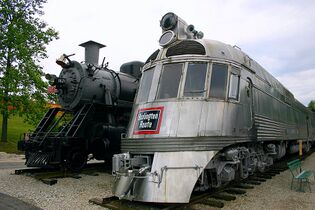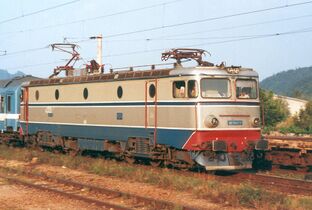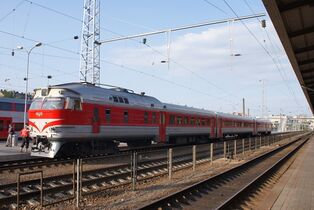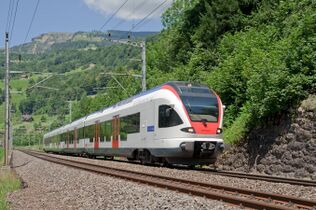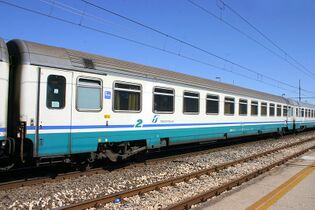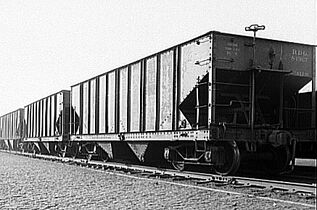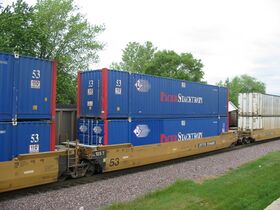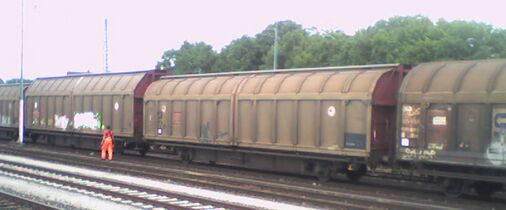Engineering:Rolling stock
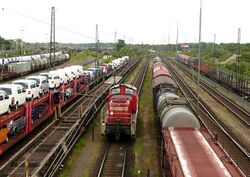
The term rolling stock in the rail transport industry refers to railway vehicles, including both powered and unpowered vehicles: for example, locomotives, freight and passenger cars (or coaches), and non-revenue cars. Passenger vehicles can be un-powered, or self-propelled, single or multiple units.[1][2][3][4] A connected series of railway vehicles is a train (this term applied to a locomotive is a common misnomer).
In North America, Australia and other countries, the term consist (/ˈkɒnsɪst/ KON-sist) is used to refer to the rolling stock in a train.[5]:1‑129
In the United States, the term rolling stock has been expanded from the older broadly defined "trains" to include wheeled vehicles used by businesses on roadways.[6][7][8]
The word stock in the term is used in a sense of inventory. Rolling stock is considered to be a liquid asset, or close to it, since the value of the vehicle can be readily estimated and then shipped to the buyer without much cost or delay.[9][10] The term contrasts with fixed stock (infrastructure), which is a collective term for the track, signals, stations, other buildings, electric wires, etc., necessary to operate a railway.
Gallery
- Rolling stock
-
Steam and diesel locomotives
-
Diesel multiple unit (DMU)
-
Electric multiple unit (EMU)
-
Railcar
-
Passenger car or coach
-
Hopper car, one of many types of revenue freight cars
-
Articulated well cars with intermodal containers
-
European covered goods wagons
See also
- Goods wagon
- List of railway vehicles
- Railroad car
References
- ↑ "Yaxham Light Railway rolling stock page". http://www.yaxham-light-railway.fsnet.co.uk/Rolling_Stock/rolling_stock.html.
- ↑ "Definition of "rolling stock" from the Oxford English Dictionary accessed 5 February 2007 (subscription service)". http://dictionary.oed.com/cgi/entry/50208215?single=1&query_type=word&queryword=rolling-stock&first=1&max_to_show=10.
- ↑ "Definition of "rolling stock" from the Concise Oxford Dictionary". http://www.askoxford.com/concise_oed/rollingstock?view=uk.
- ↑ "Definition from the American Heritage Dictionary". http://www.bartleby.com/61/0/R0290000.html.
- ↑ McAuliffe, Des (1999). "The Snowtown to Port Pirie line". Modelling the Railways of South Australia. Adelaide. https://catalogue.nla.gov.au/Record/6937092.
- ↑ "Rolling stock". Farlex. http://financial-dictionary.thefreedictionary.com/rolling+stock.
- ↑ Illinois Department of Revenue. "RUT-7: Rolling Stock Certification". http://tax.illinois.gov/taxforms/sales/vehicleusetax/rut-7.pdf.
- ↑ "Michigan's Rolling Stock Exemption". Avalara. http://www.taxrates.com/blog/2016/01/12/michigans-rolling-stock-exemption/.
- ↑ Finger, Matthias; Bert, Nadia; Kupfer, David, eds (2014). "Rail infrastructure and rolling stock: investments, asset renewal and regulation". European University Institute, Florence School of Regulation. pp. 8–9. http://fsr.eui.eu/Documents/WorkshopPaper/Transport/2014/140428InfrastructureRollingStockObserver.pdf.
- ↑ Wijnia, Y.; de Croon, J.; Liyanage, J.P. (2014). "36: Application of a Unified Reference Model Across Asset Types: Comparative Cases". in Lee, Jay; Ni, Jun; Sarangapani, Jagnathan et al.. Engineering Asset Management 2011: Proceedings of the Sixth World Congress on Engineering Asset Management. London: Springer. pp. 416–417. ISBN 978-1-4471-4993-4. https://books.google.com/books?id=x-m7BAAAQBAJ&q=%22rolling+stock%22+as+liquid+asset&pg=PA416.
External links
 |
